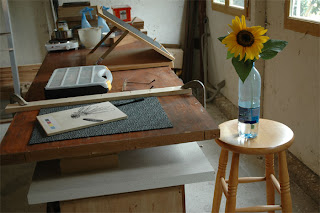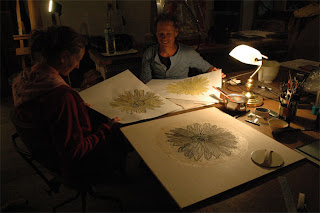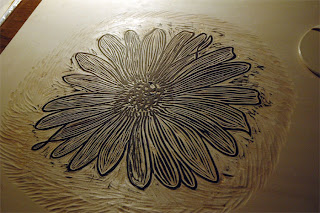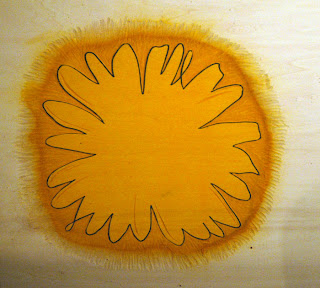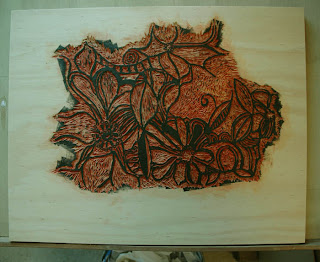Woodblock printing is fun as was so clearly shown by a couple who visited our B&B a few weeks ago.
After having seen Carcassonne and a few of the Cathar castles, cycled up some serious hilly roads and enjoyed the surroundings, they decided to have a go at woodblock printing.
Apart from remembering what they did at college during art class, like creating a linocut, no other attempt was made at printing.
They chose to do a sunflower and there were only two days left to do it. The sunflower was picked from the garden and a two block print decided upon. Each cutting one block at the same time and alternating between the blocks while cutting. It was truly a joint effort. As time was a limiting factor, all the intro about woodblock printing etc was skipped.
Not too much time was spent on various techniques apart from how to cut a fine line with particular attention to the direction of the grain of the timber, an explanation of the importance of correct registration and keep the hands and fingers at all times behind the gouges. Dave Bull's (founder of the Baren Forum) favourite motto is "Cut - Print". No more aptly demonstrated in this case.
As blocks we used two pieces of poplar ply, which is readily available here. The design was drawn straight on the block with a felt pen, copied on tracing paper and transferred to the second block using carbon paper. Of course making sure the registration was right.
After that it was all downhill. I'd imagined that after a few hours they would have liked a break and do some more sightseeing, but no, they were hooked (line and sinker included for sure).
Not much explaining was required after that apart from the odd tip and a bit of guidance. They really took to it like ducks to water. It was a joy to watch. Anyway at the end of day one and printing very late in the evening, as it was rather hot in the afternoon, we had the first proofs.
For the yellow, deep cadmium yellow dry pigment with rice paste was used, Moku Hanga fashion. That was just and only just possible as the humidity was very low indeed. For the black we had to resort to oil based etching ink as it was an absolute no show using Sumi or the like. The paper was 200 gms cartridge. Because of the nature of the print and the weight of the paper I'd imagined to get away with not moistening the paper and I did: it did not cockle or warp.
They had a go, using the brush for applying the pigment, using the brayer, placing the paper correctly, making use of the registration slots (kento's), printing with the Baren, in short the works and in the end, there it was, the smile.
The advice was, what you don't cut now, you can always cut away later. Not the other way round. Thus it was decided by the the two xylographers to cut away more in the petals, keeping in mind the natural shading and overlapping of the petals. This adds some depth to the image.
Also some repairs were required to the sunflower heart which they did themselves. There was discussion on how to finish the ends of some of the petals and how to to achieve it. This was tried on a separate block before cutting the actual block.
This was all done the next day, after which we made the final print.
During printing the paper picked up some pigment outside the actual image. However I believe it only enhances the playfulness and vibrance of the sunflower head and suggests movement.
Thursday, August 26, 2010
Sunday, July 18, 2010
Setting up a printing workshop
These days it’s a Nikon D70 I use with a few extra lenses. That, combined with a computer and Adobe professional Photoshop CS, enables you to do just about anything you can possibly turn your mind to. I do not have to elaborate on that because everyone knows and it is not really that interesting.
Much more fun it was some years ago using an Agfa Clack. I was boarding with a gentleman in Medan, Indonesia who introduced me to the darkroom and processed the first pictures made with that Agfa (still using red light during processing). After that a procession of Zeiss Ikon nettar, Ikoflex, Werra, M3 with the most beautiful lens I ever had (a Summicron 135 mm), Nikkormat and now the D70.
Creating a woodcut print is fun. It takes planning and the visualisation of what you hope to achieve. It is something you need to learn, but it is not rocket science. Everyone has an artistic bent somewhere and sometimes you may have to dig a bit deeper to find it, but the skill to translate an idea into a woodblock print can be learned step by step and once acquired will apply to anything that follows.
This blog is additional to my website . It is meant to deal mainly with the new adventure of setting up a printing atelier in the South of France. Apart from using it myself of course, the idea is to create a place where anyone can come, when one can learn about the timber, the chisels, how to use them, transferring images and printing, find out that nothing is straight forward and that there are infinite ways to skin a cat. Not meant personally cats, I like you too.
Anyway, it is all taking shape veeery slooowly ( see link), but we are getting there. Three presses, several working tops. Presently a wet bench with a large size sink under construction. Also setting up for etching with copper sulphate on zinc with or without electrolysis. Paper drawers. Letter type sets (for extra interest) etc, etc.
If you are already a printer and artist, you find yourself in these regions and want to play with all this, but haven’t got the facilities you are perfectly welcome too. There is no pretence. We are all equal and are all learning all of our lives and then we can forget.
To warm the place up, I’ve had the help (and still have) of some friendly students to get the atelier and its concept together. On this page are some photos of them at work. One of the students had to meet a deadline with at least one stage of her print of which the result is shown. This block is by no means ready and there will be three more blocks before the final print is made.
 Alice's print printed on Kochishi in two stages, first stage the wash was printed using the thumbs to push the moist paper down between the relief
Alice's print printed on Kochishi in two stages, first stage the wash was printed using the thumbs to push the moist paper down between the relief
However and here is the point I was trying to make after this long and cumbersome introduction. When the paper was pulled of the block there was the magic and a happy face and I hope to see a few more.
Much more fun it was some years ago using an Agfa Clack. I was boarding with a gentleman in Medan, Indonesia who introduced me to the darkroom and processed the first pictures made with that Agfa (still using red light during processing). After that a procession of Zeiss Ikon nettar, Ikoflex, Werra, M3 with the most beautiful lens I ever had (a Summicron 135 mm), Nikkormat and now the D70.
It was magic then. It took planning. The visualisation of what you wanted to achieve. Pick the right moment in the 24 hrs, the right light the right everything. Pick the right sort of film, developer, paper and all the tricks in your memory etc, etc, (now using amber light during the process). Then the magic moment was there, just as you wanted it or still a surprise anyway.
That applies to woodcut or woodblock printing. Not the index finger and a mouse to operate the printer hanging at the end of your computer or even more simple, buy some print in a store because it matches the curtains.Creating a woodcut print is fun. It takes planning and the visualisation of what you hope to achieve. It is something you need to learn, but it is not rocket science. Everyone has an artistic bent somewhere and sometimes you may have to dig a bit deeper to find it, but the skill to translate an idea into a woodblock print can be learned step by step and once acquired will apply to anything that follows.
This blog is additional to my website . It is meant to deal mainly with the new adventure of setting up a printing atelier in the South of France. Apart from using it myself of course, the idea is to create a place where anyone can come, when one can learn about the timber, the chisels, how to use them, transferring images and printing, find out that nothing is straight forward and that there are infinite ways to skin a cat. Not meant personally cats, I like you too.
Anyway, it is all taking shape veeery slooowly ( see link), but we are getting there. Three presses, several working tops. Presently a wet bench with a large size sink under construction. Also setting up for etching with copper sulphate on zinc with or without electrolysis. Paper drawers. Letter type sets (for extra interest) etc, etc.
If you are already a printer and artist, you find yourself in these regions and want to play with all this, but haven’t got the facilities you are perfectly welcome too. There is no pretence. We are all equal and are all learning all of our lives and then we can forget.
To warm the place up, I’ve had the help (and still have) of some friendly students to get the atelier and its concept together. On this page are some photos of them at work. One of the students had to meet a deadline with at least one stage of her print of which the result is shown. This block is by no means ready and there will be three more blocks before the final print is made.
 Alice's print printed on Kochishi in two stages, first stage the wash was printed using the thumbs to push the moist paper down between the relief
Alice's print printed on Kochishi in two stages, first stage the wash was printed using the thumbs to push the moist paper down between the relief
Subscribe to:
Posts (Atom)
